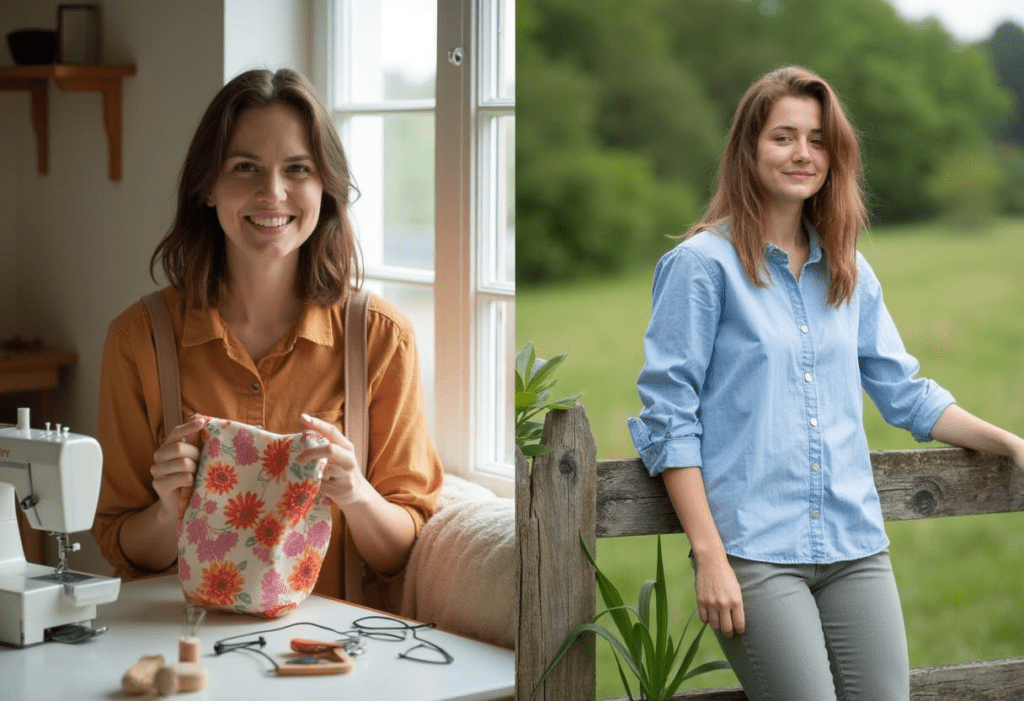A Closet Conundrum
Last week, I stood in my closet, holding two shirts—one a soft organic cotton tee I snagged for my brother, the other a silky number I’d gifted my partner. Both felt “right” in my hands, but why? Was it their eco-friendly vibe or the fair vibes behind them? As an Amazon Affiliate who’s all about ethical clothing, I’ve been down this rabbit hole before, trying to untangle ethical fashion from sustainable fashion. They sound like twins, but they’re more like cousins—related, yet distinct. I’ve spent hours researching, chatting with friends, and digging into brands, and I’m here to spill what I’ve learned. Whether you’re shopping for the men in your life (like I often do) or rethinking your own wardrobe, understanding this difference is a game-changer. Ready to dive into the fabric of fashion with me? Let’s unravel these terms, stitch by stitch, and figure out what they mean for us in 2025.
The Heart of the Matter: Defining the Terms
Fashion’s buzzwords can feel like a tangle, so let’s start with the basics—straight from my notebook to you.
- Ethical Fashion: This is about people—fairness, dignity, and justice. It’s the promise that the hands stitching your shirt aren’t trembling from hunger or exhaustion. Ethical fashion demands fair wages (think living wages, not pennies), safe working conditions (no sweatshops), and respect for workers’ rights. It’s why I adore brands that flaunt Fair Trade logos or transparency about their factories. Picture a seamstress in Bangladesh smiling because she’s paid enough to feed her kids—that’s ethical fashion’s heartbeat.
- Sustainable Fashion: This one’s about the planet—keeping Earth’s air clean, water pure, and landfills empty. It’s fabrics like organic cotton (no pesticides poisoning rivers) or merino wool (biodegradable, not plastic). It’s also about durability—clothes that last years, not weeks. When I see a shirt that’s compostable or made with 18% less energy than polyester (per 2021 sustainability data), I know it’s sustainable.
Here’s the twist: they overlap. A shirt made ethically might use sustainable materials, but not always. I’ve found ethical brands using synthetic dyes, and sustainable ones silent on worker pay. They’re two sides of a coin—people and planet—but they don’t always flip together. Let’s break it down further.
People vs. Planet: Where They Diverge
Imagine this: I’m eyeing a dress shirt on Amazon for my dad. It’s organic cotton—sustainable win! But the label’s mum on who made it. Was it a sweatshop? Suddenly, my eco-high fades. That’s where ethical and sustainable fashion part ways.
- Ethical Fashion’s Focus: It’s laser-sharp on human lives. Take the 2013 Rana Plaza collapse in Bangladesh—1,134 garment workers died because of unsafe conditions. Ethical fashion fights that horror with standards like Fair Trade or SA8000 certification. I’ve seen brands like Pact (one of my faves) touting fair wages and safe factories—it’s personal, human, raw. But here’s the catch: an ethical shirt might still be polyester, piling up in landfills. People-first doesn’t always mean planet-first.
- Sustainable Fashion’s Focus: This is Earth’s champion. Think hemp tees or recycled denim—materials that slash water use (cotton takes 2,700 liters per shirt, organic cuts that down) or carbon footprints. Brands like Woolly Clothing Co. with their merino wool obsess over biodegradability. Yet, I’ve noticed some sustainable labels dodge labor questions. A shirt might save the planet but exploit the maker—ouch.
- The Gray Zone: Sometimes they dance together beautifully. Organic cotton from a fair trade co-op? Double win. But I’ve learned to ask: Is this ethical and sustainable, or just one? It’s why I dig into brand stories—because “good” isn’t one-size-fits-all.
Real-World Threads: Examples That Tell the Tale
Let’s get tangible—I’ve pulled some examples from my shopping hunts to show how this plays out.
- Ethical Star: Pact: Their organic cotton tees (available on Amazon!) are Fair Trade certified. I know the farmers and sewers are treated right, but cotton’s water use nags at me—sustainable, yes, but not the greenest fabric out there.
- Sustainable Star: Woolly Clothing Co.: That merino wool shirt I got my dad? Biodegradable, low-impact, and lasts forever. Woolly’s ethical too, but their focus is sustainability—wool’s renewable magic shines brighter than labor details.
- Fast Fashion Fail: A cheap polyester shirt from a big chain might be neither—sweatshop-made and landfill-bound. I’ve ditched those for good.
- Dream Team: Everlane: Not on Amazon, but their transparent factories and recycled fabrics hit both marks. It’s rare, but it’s the gold standard I chase.
I’ve styled these for the guys in my life, and the difference clicks when you feel the fabric and read the story. Ethical keeps me warm inside; sustainable keeps me hopeful for tomorrow.
Why It Matters in 2025: A Fashion Crossroads
In 2025, this isn’t just geeky fashion trivia—it’s a call to action. Fast fashion’s still choking rivers and workers—$500 billion in waste yearly, says the Ellen MacArthur Foundation. Ethical fashion fights for the 75 million garment workers worldwide (mostly women), while sustainable fashion tackles the 92 million tons of textile trash we dump annually. I want the men I shop for—my brother, my partner, my dad—to wear shirts that don’t hurt anyone or anything. Brands on Amazon, like Cotton King or LilySilk, are stepping up with organic cotton and silk, but I’ve learned to peek behind the curtain. Are workers paid fair? Is the planet spared? It’s a balance we’re all figuring out, and every choice counts.
Wrap-Up: Your Fashion Compass
So, ethical or sustainable? For me, it’s not a cage match—it’s a duo I root for. Ethical fashion hugs the people; sustainable fashion cradles the Earth. Next time I’m picking a shirt on Amazon, I’ll ask: Who made this? What’s it made of? How long will it last? You can too—whether it’s for your guy or your own closet. Check out my guide to GOTS certified brands (#) for sustainable picks or my ethical fashion tips (#) for more. Fashion’s messy, but it’s ours to shape. Let’s make it beautiful—inside and out.
